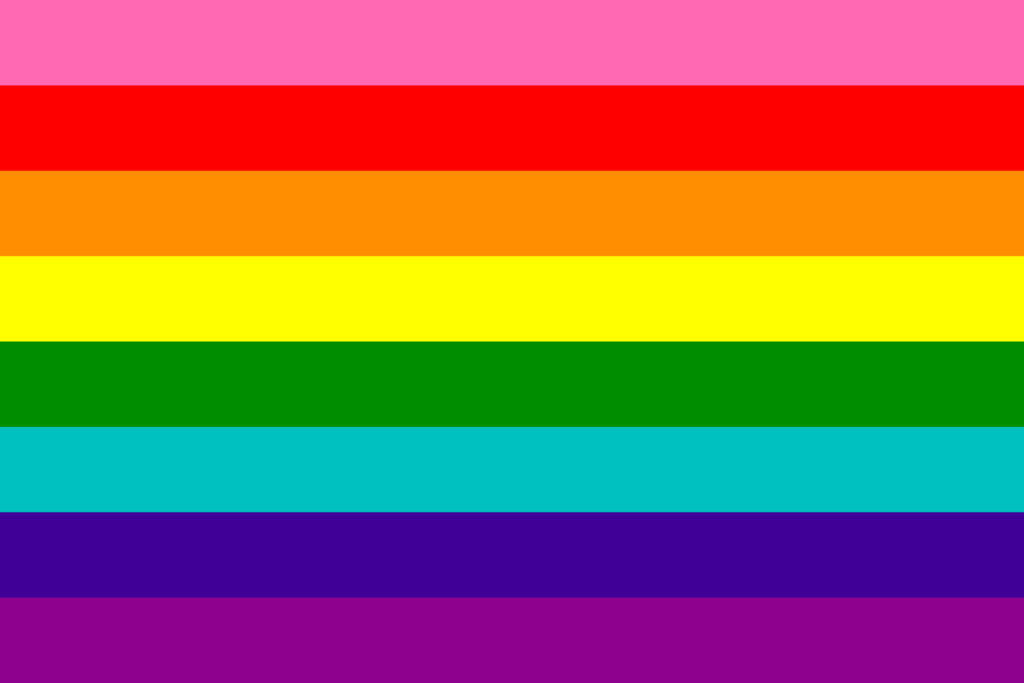Before gay artist Gilbert Baker designed the first pride flag in the late 1970s, the only widely recognized marker of our sexual orientation was the pink triangle used by the Nazis to identify and persecute homosexuals. Just as the pink triangle reflected same-sex orientations, so too would our new flag represent gay, lesbian, and bisexual people of all ages, interests, beliefs, and appearances. The pride flag celebrated same-sex orientations, regardless of whether or not individuals conformed to gender constructs. It celebrated gay men who performed in dresses and wigs. It celebrated butch lesbians who rejected the trappings of “femininity.” Sexual orientation—our innate attraction to the same sex and the source of our oppression—now became the source of our pride.
The pride flag’s original eight colors—signifying sex, life, healing, sunlight, nature, magic/art, serenity, and spirit—were eventually reduced to the six we see most often today. Ironically, the stripe representing “sex” was the first to be removed. While a number of secondary pride flags arose over time, including one specific to lesbians and another for bisexuals, these flags consistently addressed the oppression faced by same-sex oriented people, lesbians especially, in a heteropatriarchal society. These flags were not meant to represent anyone and everyone. They had a purpose: to liberate all same-sex oriented people from the institutionalized homophobia that existed—and still does, to a lesser degree in some countries—on a global scale.
Today, historic “gay pride” has been watered down and broadened, commercially and socially, to simply “pride.” In the name of inclusivity, we are told that our movement—and by extension, our flag—must be rebranded to center heterosexual males who “identify” as lesbians; heterosexual females who “identify” as gay men; asexuals, who lack a same-sex orientation by definition; our alleged allies; and anyone who wishes to call themselves “queer.”
Today, “queer” often means whatever an individual wants it to mean—ultimately stripping the word of any meaning at all. Indeed, the infamous “+” at the end of “LGBTQIA+” leaves the door open for anyone and everyone to demand a place in the “pride” community, including those who are entirely straight. In this contemporary movement riddled with right-wing religious extremism, a liberal obsession with competitive wokeness over critical thought, and anti-feminist backlash across the political spectrum, we as LGB people are no longer permitted to focus our movement on ourselves and our rights—or even to name our specific oppression.

Over time, “gay rights” organizations became “equality” organizations. These became “LGBTQIA+” organizations and eroded further into gender identity propaganda machines that no longer represented the rights or voices of those who are exclusively same-sex attracted. This devolution necessitated the explosive formation of LGB Alliance branches throughout the world over the past year and a half.
Despite being the only group in the U.S. specifically and exclusively dedicated to the liberation of gay, lesbian, and bisexual people, we have faced astonishingly violent backlash for adhering to the roots of our own historic rights movement. We and our supporters have faced death threats, rape threats, loss of employment, destroyed reputations, social ostracization, deplatforming, slander, media censorship, and physical assault for rejecting the regressive ideology of the gender identity movement, which claims sex classes do not exist as a tangible or relevant reality, and that homosexuality—exclusive same-sex attraction—is a bigoted “genital fetish.” We are told that individuals are whatever and whomever they claim to be. We are pressured to “unlearn” our sexual “preferences” in order to accept and validate opposite-sex partners to whom we are not attracted. It is not a coincidence that this rhetoric sounds remarkably similar to classic conversion therapy: the homophobic attempt to convert same-sex oriented people into heterosexuality.
Same homophobia, “woke” new packaging.
We have not been deterred. As a growing, volunteer-run and lesbian-led organization, LGB Alliance USA unanimously decided to represent ourselves and our image through Baker’s original flag as a symbol of homosexual liberation.
We’ve been fighting this battle a long, long time—and we have no intention of giving up.


I love this! Thank you for the work you do! ❤️❤️❤️
Muito grata por vocês existirem.
Parabéns pela coragem e bravura.
Abraços fraternos de uma lésbica brasileira.
Yes! The original flag. We mustn’t give it up. The new design is ugly, but you know it won’t last. They’ll must needs add more “representative” colors as new groups are added to LGBTQWTF+.
I have been upset by the affirmative use of “queer” by people claiming to be for the rights of lesbian/gay/bisexual people. It’s as if people were to start using “n••••r” to refer to people of African origin and insist that this was affirmative and not pejorative.
exactly
Excellent writing. Thank you.
I’d love to see that “Our history will not be erased” image as a future shirt design!